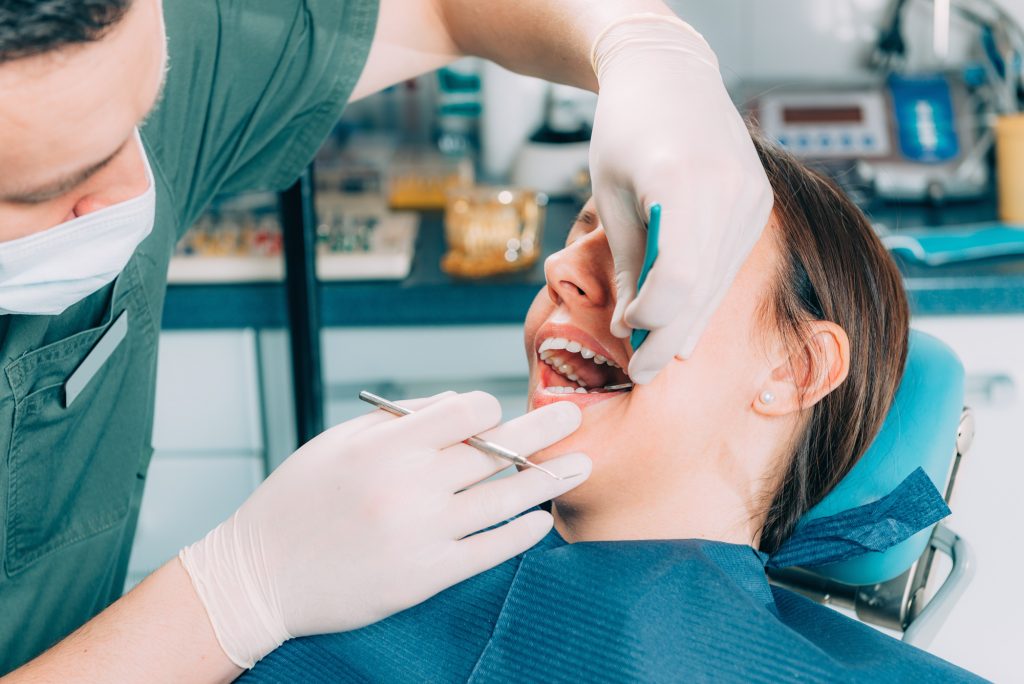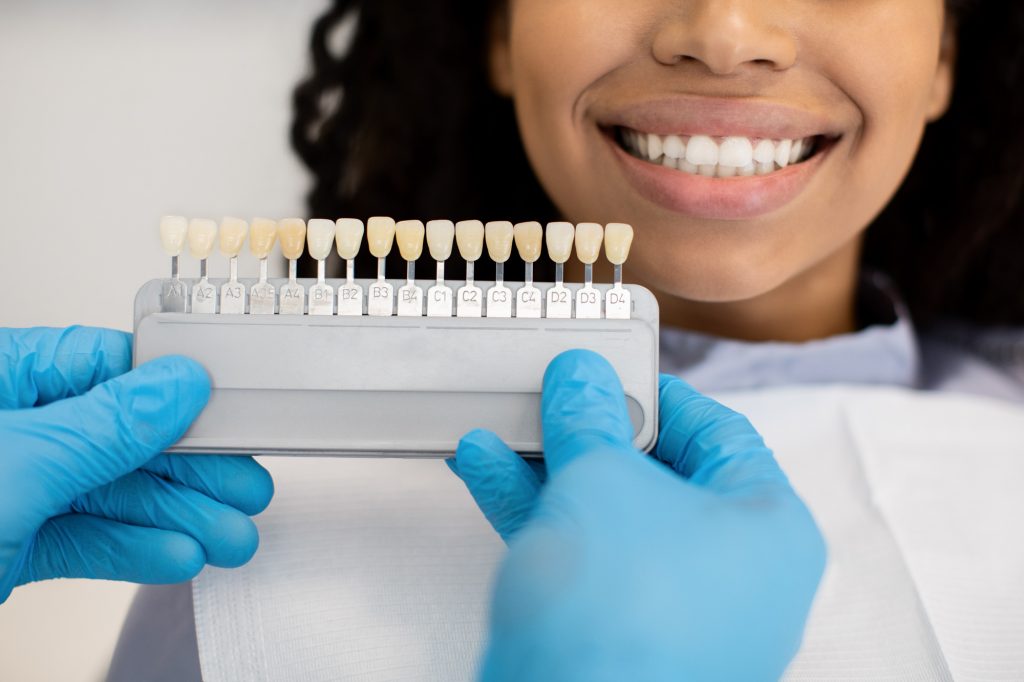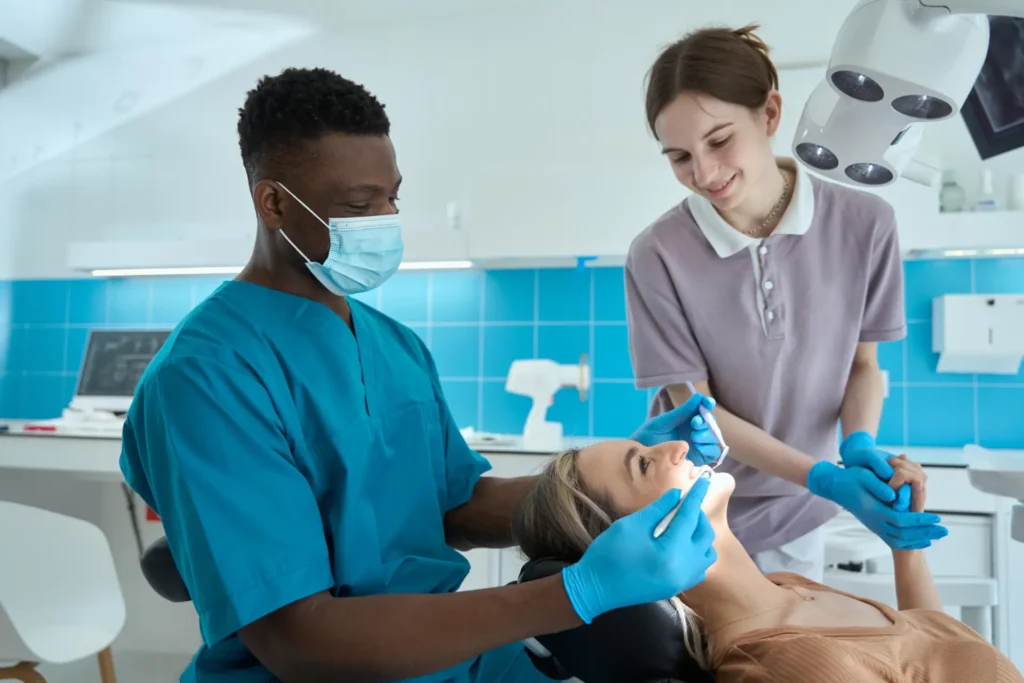The Rise of Digital Dentistry
Using innovative tools and techniques, dentists can now offer a far more streamlined and less invasive experience for patients. From digital X-rays to intraoral scanners and CAD/CAM technology, digital dentistry provides precise and efficient solutions.
Painless Procedures: Laser Dentistry
One of the most revolutionary advancements in dental technology is the introduction of laser dentistry. Laser dentistry has turned the tables by offering a virtually painless alternative to traditional dental procedures. The use of lasers in dentistry is diverse, encompassing a wide range of treatments, and has led to a remarkable reduction in patient discomfort and healing times.
How Does Laser Dentistry Work?
Well, it is simple yet effective. A laser, which stands for Light Amplification by Stimulated Emission of Radiation, produces a very narrow, intense beam of light energy. When this light interacts with the tissue, it causes a reaction. The light produced by the laser can remove or shape tissue, providing dentists with a high degree of control and precision, minimizing damage to surrounding tissues.
Laser Dentistry for Cavity Treatment
Traditionally, the thought of a drill was enough to make patients wince. But with laser dentistry, that fear can be put to rest. Lasers can efficiently remove decay within a tooth and prepare the surrounding enamel for a filling. The process is so comfortable that it often eliminates the need for anaesthesia, thereby making the whole experience less daunting for patients.
Gum Surgery and Laser Dentistry
Gum surgery is another area where laser dentistry has made significant inroads. Procedures that were once invasive and required considerable healing time are now significantly less so & have minimal discomfort. Laser gum surgery involves using a dental laser to remove the inflamed gum tissue from around the root of the tooth. This allows our dentists to effectively and gently treat gum disease and promote the healthy growth of gum tissue.

Laser Teeth Whitening: A Brighter Smile in No Time
Teeth whitening has become one of the most requested cosmetic dental procedures, and laser dentistry has a pivotal role to play here. Unlike traditional whitening methods that can take weeks to show results, laser teeth whitening can brighten your smile in just a single session. The procedure involves applying a bleaching agent to your teeth followed by the use of a laser to activate the whitening solution. The result is teeth that are several shades whiter, achieved in a fraction of the time.
The Benefits of Laser Dentistry
Beyond the painless procedures, there are several other benefits to laser dentistry. Lasers are incredibly precise, reducing the risk of damaging healthy parts of the tooth or gums during treatment. Laser treatments often result in less bleeding and swelling post-procedure compared to traditional methods, thereby accelerating healing times. Additionally, lasers sterilize the areas they touch, reducing the risk of infection
Our Commitment to Advanced Dental Care
At College Gate Dental, we are dedicated to providing our patients with the highest quality dental care and are continually exploring new technologies and treatments that can improve patient outcomes. While we currently do not offer laser dentistry services, we are closely monitoring advancements in this field with the aim of incorporating such innovative procedures into our practice in the future. We believe that staying informed about the latest dental technologies helps us maintain our commitment to excellence and patient satisfaction.
As technology continues to evolve, we can expect laser dentistry to play an even more significant role in creating positive dental experiences. We appreciate your understanding and look forward to serving you with the best available treatments. If you have any questions or would like to know more about our current services, please feel free to reach out to us.
Virtual Reality: A Game Changer for Dental Anxiety
Most people associate Virtual Reality (VR) with immersive gaming and cutting-edge entertainment. It is now gaining traction in a surprisingly different field: dentistry. VR has become a game-changer in the way dental professionals help patients combat dental anxiety. By creating a calming, immersive virtual environment during treatment, VR not only distracts patients but also significantly reduces fear and promotes relaxation.
Understanding Virtual Reality in Dentistry
VR in dentistry involves the use of a VR headset that takes you the patient on a visual journey away from the dental chair. This could be a serene beach, a tranquil forest, or any other calming environment. As patients become engrossed in this virtual world, they are less aware of the dental procedure underway, leading to a more relaxed and anxiety-free experience.
Why VR Works: The Psychology Behind It
The effectiveness of VR in reducing dental anxiety is grounded in psychology. The human brain typically struggles to process too many stimuli simultaneously. When a patient is engaged in a VR experience, the brain becomes occupied with the virtual environment, reducing its focus on the dental procedure. This psychological concept, known as divided attention, is what makes VR an effective tool for managing dental anxiety.
VR and Pain Perception: A Surprising Connection
Beyond simply serving as a distraction, VR can also alter your perception of pain. Several studies have shown that using VR during dental procedures can lead to a reduced pain experience. This is because VR can influence how the brain processes and responds to pain signals, further enhancing your comfort during dental procedures.

The Broader Impacts of VR in Dental Practices
In addition to its direct benefits to patients, VR can potentially increase patient satisfaction and loyalty, as you likely appreciate the steps taken to make the experience more comfortable. This, in turn, can improve the reputation of our dental practice – helping us attract more patients. Additionally, a more relaxed you is easier to treat, making the dentist’s job smoother and more efficient.
The Future of VR in Dentistry
With the rapid advancements in VR technology, we can expect even more immersive and interactive experiences that further alleviate dental anxiety. For instance, future VR applications could potentially allow patients to control aspects of the virtual environment, giving them an added sense of control and distraction during procedures.
In conclusion, VR is more than just a novel tech gadget in the dental world; it’s a potent tool transforming the patient experience. By offering an effective way to manage dental anxiety, it’s enhancing patient comfort, promoting relaxation, and ultimately reshaping perceptions of dental care. As VR technology continues to advance, its role in dentistry is only set to grow, ushering in a new era of pain-free and anxiety-free dental experiences.
Sedation Dentistry: Taking the Edge Off
For many people, the mere mention of a visit to the dentist can send a wave of anxiety rushing through their bodies. But thanks to the arrival of sedation dentistry, those fears can be significantly alleviated.
Sedation dentistry uses a range of techniques, from mild sedatives to general anaesthesia, ensuring that dental procedures are not only pain-free but also comfortable.
Understanding Sedation Dentistry
Sedation dentistry involves the use of medication to help patients relax during dental procedures. The level of sedation can vary depending on the patient’s needs and the complexity of the dental work. It ranges from minimal sedation, where patients are awake but relaxed, to general anaesthesia, where patients are completely unconscious.
The Types of Sedation in Dentistry
Sedation in dentistry can be administered in several forms, each serving a unique purpose.
- Inhaled Minimal Sedation: This involves breathing in nitrous oxide, or “laughing gas,” combined with oxygen through a mask placed over your nose. The gas helps patients relax, and its effects wear off quickly, allowing patients to drive home after the procedure.
- Oral Sedation: Oral sedation can range from minimal to moderate, depending on the dosage. For minimal sedation, a pill is taken about an hour before the procedure. For moderate sedation, a larger dose may be given. This is the most common type of anaesthesia used in sedation dentistry.
- IV Moderate Sedation: With this method, a sedative drug is delivered through a vein, which allows it to take effect more quickly. The level of sedation can be continuously adjusted during the procedure.
- Deep Sedation and General Anaesthesia: These medications make patients either almost unconscious or fully unconscious during the procedure.
The Benefits of Sedation
The benefits of sedation dentistry extend beyond simply alleviating anxiety. For patients with a low pain threshold, sedation dentistry can make lengthy procedures bearable. It’s also beneficial if you have a strong gag reflex or are unable to sit still in a dentist’s chair. Moreover, sedation dentistry allows dentists to perform multiple treatments in one session, saving time and reducing the number of appointments needed.
Sedation Dentistry: A Safe Solution?
While the idea of sedation might cause some apprehension, the techniques used in sedation dentistry are generally safe when administered by experienced dentists. However, patients with certain medical conditions should talk to the dentist before considering sedation.
The COVID-19 pandemic has acted as a catalyst for the adoption of digital technology in dentistry. With the emphasis on minimizing physical contact and reducing clinic visits, many dental practices have accelerated their digital transformation journeys.
There’s no doubt that dental technology is transforming the patient experience, turning fear and apprehension into a sense of calm, greater trust & relaxation.
With advances like laser dentistry, VR, AI, and more, we’re witnessing a major shift in the way dental care is delivered. As these technologies continue to evolve and become more mainstream, the day when dental fear becomes a thing of the past may not be too far off.
Indeed, the future of dentistry is bright and promising. The adoption of advanced technology means that dental practices can cater to a broader patient base, including those who would previously avoid dental visits due to fear or anxiety.
As more and more dental practices embrace these changes, we can look forward to a world where dental appointments are not a source of dread, but rather an essential part of maintaining overall health and well-being.
Let’s welcome this new era of dentistry with open arms and, more importantly, open mouths!
Modern Dentists Near Me
College Gate Dental are a leading dental clinic in Glasnevin, Co. Dublin. Our highly qualified team provide professional dental care with state-of-the-art technology. We offer affordable payment plans and a full range of specialist and general dental services (dental examination, dental hygienist, Deep cleaning, scale & polish, fillings, extractions, wisdom teeth, root canal, crowns, emergency dental treatment, dental implants, composite bonding, veneers & teeth whitening.
Our experienced staff take great care to make your visit comfortable and pain-free & we do have availability for new patients. We are committed to the highest quality dental care for our patients in Glasnevin, Drumcondra, Santry, Whitehall, Phibsborough, and surrounding areas. Call us today to make an appointment.”
Frequently Asked Questions on pain free dental treatment
How does laser dentistry contribute to pain-free dental procedures?
Laser dentistry uses focused light beams to remove or shape tissue during dental procedures. This technology offers a high degree of control and precision, reducing damage to surrounding tissues. As a result, it often eliminates the need for drills and cuts down on discomfort during procedures such as cavity treatment or gum surgery. Moreover, healing times are usually quicker due to less trauma to the tissues and inherent sterilization properties of the laser.
How is Virtual Reality (VR) used in dentistry to alleviate anxiety?
VR is used in dentistry to provide a distracting, calming environment for patients during their procedures. Patients wear a VR headset that immerses them in a virtual world, such as a serene beach or tranquil forest. This diversion helps to occupy the patient’s mind, reducing their focus on the dental procedure and making the experience less stressful.
What is sedation dentistry and how does it help in making dental procedures painless?
Sedation dentistry involves using medication to help patients relax during dental procedures. The level of sedation can vary from minimal, where the patient is relaxed but awake, to general anesthesia, where the patient is completely unconscious. This variety allows dentists to customize the level of sedation to the patient’s comfort and the requirements of the procedure, ensuring a pain-free experience.
What role does AI play in making dental visits less painful?
AI plays a significant role in painless dentistry by improving diagnostic accuracy and treatment planning. AI algorithms can analyze dental images for signs of oral diseases, often catching them earlier than the human eye can. Early detection often leads to less invasive and less painful treatments. Moreover, AI can aid in precise treatment planning, reducing the time and discomfort associated with procedures.
How does tele-dentistry contribute to a more comfortable dental experience?
Tele-dentistry allows patients to consult with their dentists remotely, reducing the need for in-person visits. Patients can discuss their concerns, show visible issues, and receive advice without leaving their homes. This is particularly beneficial for routine follow-ups or minor concerns, saving patients time and reducing their anxiety about visiting the dental office.
Can technology completely eliminate pain and discomfort in dental procedures?
While current dental technologies significantly reduce pain and discomfort, some procedures may still cause minor discomfort due to the nature of the treatment. However, advancements like laser dentistry, sedation, and AI have made dental procedures much more comfortable than in the past. As technology continues to evolve, we can expect further improvements in patient comfort during dental procedures.


